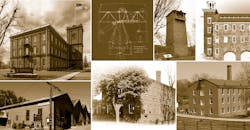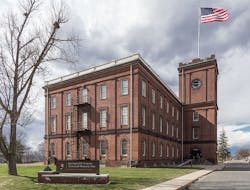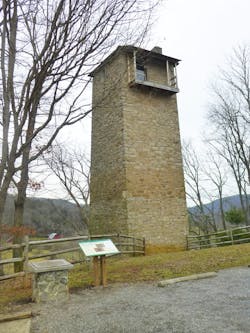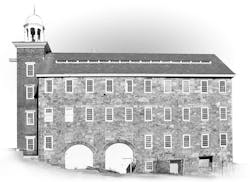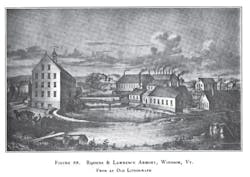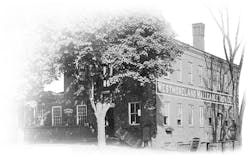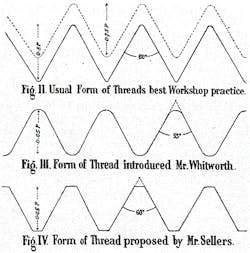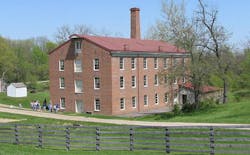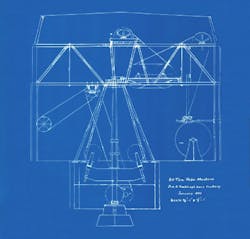9 Early American Manufacturing Landmarks
Many Americans made significant contributions to the Industrial Revolution. A relatively unspoiled continent chock full of resources provided the resources and incentives for inventors and engineers to kickstart the U.S. into the 20th Century. Here are some examples of the outstanding engineering and ingenuity behind their successes which were copied and shared worldwide.
Springfield Armory (1794)
To supply his Continental Army with weapons, George Washington helped form the U.S.’s first national armory in Springfield, Mass. It supplied weapons for every war the U.S. fought when it was operational, which was until 1968. It also ushered in a host of machine tool innovations, including the Blanchard lathe, which could duplicate irregularly shaped parts such as wooden gun stocks. Rather than relying on a workshop full of carvers, it could reproduce a dozen exact copies simultaneously. Interchangeable parts were also partially developed there, as well as a set of precision gauges which contributed to manufacturing standards. One of the most famous of the many weapons designed and built there includes the Garand M-1. More than 5.5 million were built and used during WWII and the Korean conflict. And between 1939 and 1945, the time needed to make one was slashed by 75%
Jackson Ferry Shot Tower (1807)
This shot tower in Virginia is one of the few surviving buildings for making spherical lead shot. It consists of a 75-ft tower built above a 75-ft deep shaft. At the bottom of the shaft, a 150-ft long tunnel runs to a nearby riverbank which supplied water to the tower. During production, lead from a nearby mine was melted at the top of the tower and poured through a sizing sieve to create consistently sized droplets. They dropped down the tower and shaft, and during the fall, surface tension forced the molten lead into spheres that solidified before collecting in a water-filled kettle at the bottom. The lead shot from this tower was mainly used to hunt small game, and it could turn out three to four tons of it per day. Production at the tower stopped in 1839.
Wilkinson Mill (1810)
The Wilkinson Mill in Pawtucket, R.I. played critical roles in the development of textile technology and steam-power generation, as well as in fostering the machine-tool industry. Machinists there, led by David Wilkinson, built the first water-powered textile loom that had carding and spinning machines. Wilkinson was also responsible for a water-powered loom that dominated power weaving in New England for much of the 19th Century. Machinists there also helped build a steam-powered ship which predated Robert Fulton’s Clermont by 14 years. Another notable invention was a screw-cutting machine that replicated a lead screw using one of his inventions, a sliding lathe, which is now commonly found in machine shops around the world. The company also built a nail-making machine that could turn out 4,000 lb. of nails per day.
Robbins & Lawrence Machine Shop (1846)
Robbins and Lawrence took information developed and maintained at the Springfield Armory, and were the first to master the skills needed to design and make rifles which used interchangeable parts. Parts from any rifle could be used in another rifle of the same model and replacement parts could be made for it. This let the two machinists fulfill a contract for 25,000 U.S. Army rifles (Model 1841). They delivered a similar number of the same rifles to the British. This was made possible by improving and refining standard and special-purpose machine tools, letting them deliver the tolerances needed for repeatability and, therefore, interchangeability. The two also made such good use of milling machines and turret lathes that they are now common in manufacturing.
Westmoreland Iron Works (1850)
This foundry was the oldest malleable iron company in continuous operation in the United States until it closed in 1990. The firm was founded as Oakhill Malleable Iron Co. in 1833 and was established under its Westmoreland name in 1850. Erastus W. Clark, who along with his brother-in-law Abel Buell brought the foundry to Westmoreland, ran the ironworks until 1871, and was the first of six generations who ran it until 1990. Ironworking is one of the oldest national industries, begun in the United States by Seth Boyden (1788-1870) in the 1820s. Foundries sprung up throughout the east, casting saddlery hardware, carriage parts, and agricultural implements. The railroads became the largest customer for malleable iron castings around the turn of the century, and eventually automobile manufacturers used it for rear axle housings, differential cases, hubs, and other parts.
U.S. Standard Screw Threads (1864)
Prior to 1870 or so, there were no standards for screws in the U.S., which made it difficult and expensive to find replacements. Inspired by Joseph Whitworth’s efforts to address the same problem in Britain, Philadelphia’s William Sellers decided to do the same in the U.S. So in 1864, he created a standard for screws and threads adapted for U.S. needs. For example, thread profiles were 60 deg., not 55, which simplified things for machinists and mechanics. He also thoughtfully defined pitch (threads per inch), form, and depth, as well as proportioning hex nuts for bolts from ¼ to 6 inches in diameter. By the 1880s, his standard was widespread in the U.S., letting manufacturers from coast to coast know the same fasteners would be available everywhere—a major step towards interchangeable parts for everything from typewriters to locomotives.
Watkins Woolen Mill (1868)
This 1861 woolen mill in Kentucky is not the scene or remains of any major industrial event, but it is the best-preserved 19th Century woolen mill in North America. It shows how a major industry, textiles, entered the mechanized age. On site, the owner and master mechanic, Waltus Watkins, turned raw wool into finished cloth and yard. The mill stayed in possession of the family through 1945 and, although milling wool had ceased around 1900, the family left the mill intact. The buildings and 1,600 surrounding acres were eventually bought by a group interested in preserving the site, and the state now owns and operates it as a museum.
Knight Foundry and Machine Shop (1873)
This California foundry is one of the earliest in the U.S. still operating, and one of the few powered by water. The water comes off a 400-ft ridge above Sutter Creek. In its early years, it made machinery for mining gold. The owner, Samuel Knight, patented an impulse turbine that could make use of the area’s water power for driving hoists, ore stamps, and other mining equipment. His water wheel dominated the local market until the introduction of the Pelton turbine in the mid-1880s. But Knight’s water wheels were still used into the early 20th Century, and some were used in the first hydroelectric plants in the western U.S. The shop added lumbering machinery to its output and developed the Scarifier, a road ripper that takes big ruts out of dirt roads. It saw service in Africa and Central and South America. The foundry and machine shop are still operational, turning out gray castings for industry and individual customers. It still uses a 42-in. water wheel for power installed by Knight in the 1870s.
Roebling 80-ton Wire Rope Machine (1893)
Charles Roebling, engineer and president of the Roebling Co. from 1876 to 1918, was a master at designing machines that made wire rope. He was also a genius at using his wire ropes. The milestone is the only remaining machine designed by him. It was the largest rope-closing machine when built. It twisted six strands around a central core rope, then the seven were combined or pressed together in a forming to make rope (a process called closing). Workers cold load 80 tons of wire strands to supply a single closing session, turning out 30,000 ft of unspliced cable. To handle the demand for ever longer ropes, Roebling designed a 64-ft tall machine that was so large, it had to be part of the building itself. In 1968, the same machine was modified to turn out 5-in. wire rope, the largest at the time, for surface mining. Roebling used his own cables in designing a slew of suspension bridges, including the iconic Brooklyn Bridge.
